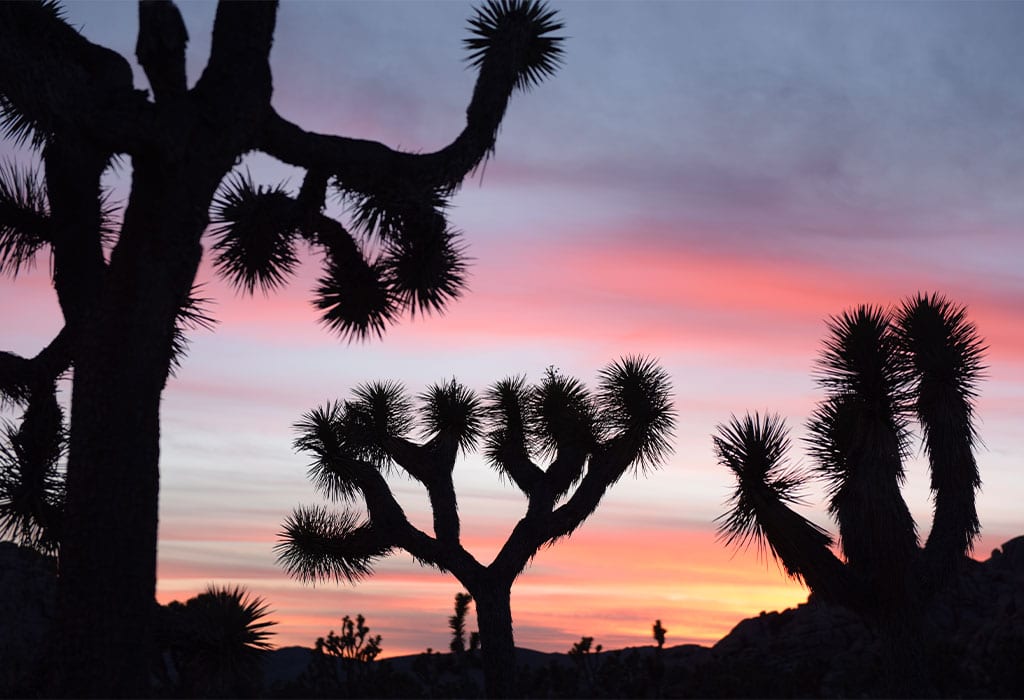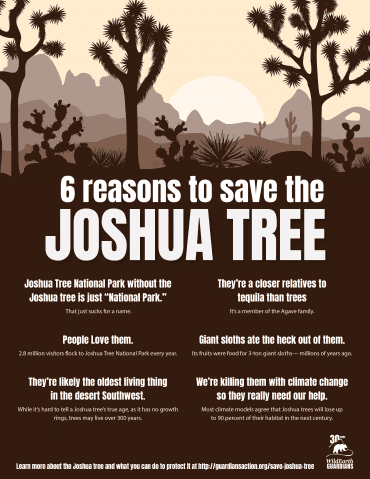A Western icon and the namesake of California’s Joshua Tree National Park, the Joshua tree’s spiny majesty has dominated Mojave Desert landscapes for thousands of years. Unfortunately, the tree’s inability to withstand the effects of climate change means it may not be around for the next hundred unless we take action now.
Reasons to save the Joshua tree
1. People love it.
From the 2.8 million visitors who flock to Joshua Tree National Park every year—including an estimated 300,000 rock climbers—to the band U2, the surreal beauty of Joshua trees captivates people worldwide.
2. Joshua Tree National Park without the Joshua tree is just “national park.”
That sucks.
3. It’s a closer relative to tequila than to trees.
The Joshua tree isn’t really a tree at all—it’s a giant yucca and a member of the Agave family.
4. Giant sloths were its biggest fans.
The species lived through the Pleistocene, when its fruits were food for giant sloths. Native Americans used the Joshua tree’s leaves for baskets and sandals and ate its flower buds and seeds. Westbound Mormons allegedly named the tree after a biblical story that mentioned Joshua, his hands outstretched. Generations later, Westerners and visitors alike continue to marvel at this strange plant.
5. We’re killing it with climate change.
Joshua trees are adapted to cold winters, hot summers, and little precipitation. With the southwest drying and warming due to climate change, most climate models agree that Joshua trees will lose up to 90 percent of their habitat in the next century.
6. It’s a moth’s best friend and a bird’s last refuge.
The Joshua tree is the product of an amazing symbiosis. Yucca moths pollinate and lay their eggs in Joshua tree flowers. As the babies grow, they eat Joshua tree seeds. Neither tree nor moth could reproduce without the other.
The tree is also a wildlife haven: 25 bird species nest in it, lizards use it for shelter, and mammals rely on it for food.
7. It’s old school.
While it’s hard to tell a Joshua tree’s true age, as it has no growth rings, trees may live over 300 years, making them probably the oldest living things in the American southwest desert.
8. It’s a slow plant in a fast world.
Joshua trees reproduce slowly. Their generation time is estimated to be between 20 and 50 years. Therefore, if we want to conserve them for future generations, we’ll need to start now.
They’re slow movers, too. The Joshua tree depends on rodents to disperse its seeds, but the rodents don’t move far from the trees. This means that when climate change threatens its habitat, the Joshua tree can’t easily expand its habitat to higher/colder/more hospitable ground.
9. It really needs our help.
Thanks to climate change, higher temperatures, longer droughts, and larger and more frequent fires are already taking their toll on Joshua trees, which need wet and cold periods to thrive and take decades to recover from fires.
Thankfully, WildEarth Guardians has a plan to protect the Joshua tree, and it starts with petitioning the U.S. Fish and Wildlife Service to protect it under the Endangered Species Act. Watch this space to find out how you, too, can help save the Joshua tree!
Download and share the infographic!
Download the “6 reasons to save the Joshua tree” infographic by clicking on the thumbnail below, then share on your social channels to spread the word about this incredible, imperiled plant!

